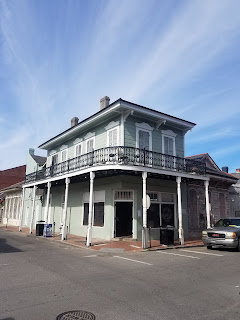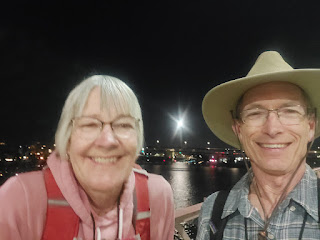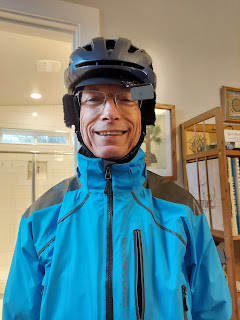Southern Comforter
New
Orleans! It’s been home for my wife and
I since late 2017, but we’re moving to Oregon, and that means decision time on
possessions. We’ve got two big billowy down-alternative comforters at The Palace
(our ironically ostentatious name for our condo) and Carol put one of them in
the discard pile. She wants to give away
or toss most of what we have and reduce our belongings to only the essential
and the dear, then outfit once again on arrival in Salem. She assumed Goodwill
wouldn’t take it, and it was headed to the landfill. I guess that would not be too heinous since
it’ll break down easy, certainly compress down when wet. But I felt sorry for
the thing, and wanted to find it a home, comforting nice people who shop at
Goodwill. A couple weeks ago when I took
it there to attempt a drop-off, they said they’d take it but would much prefer
it being washed first since someone (ahem) likes to keep his shoes on when
watching TV from bed. Thereby hangs a
tale. It’s no surprise in this city that
when you go looking for a laundromat, you end up learning about the roots of
rock and roll.
According to 64 Parishes, the quarterly magazine of the Louisiana Endowment for the Humanities, in 1924 Sicilian immigrant John Matassa opened Matassa’s Market, a small grocery store at the corner of Dauphine and St. Philip streets in New Orleans’ French Quarter.
 |
| Matassa's Market 2021(under renovation) |
His
son Cosimo grew up working in the store, but discovered his true talent and
passion for music at his father’s second business, J&M Amusement Services.
J&M provided jukeboxes for bars and restaurants. Cosimo started selling
used records from the jukeboxes when they were replaced with different songs,
and soon customers started asking for new releases as well. There were very few places to buy recorded
music in New Orleans at the time, so in 1945 Cosimo and Joe Mancuso started
J&M Music Shop (aka J&M Studios) on the corner of Rampart and Dumaine,
not far from the grocery store. Shortly
after opening they installed recording equipment in the back of the store to
fill what at the time was a dearth of places in the city to record.
The
following year, David and Julius Braun of the New Jersey record label Deluxe Records came to New Orleans, looking for fresh talent to
hopefully record on their label. They
did find talented artists, and also discovered J&M Studios. By recording right there in New Orleans, the
label wouldn’t have to pay to bring the artists to New Jersey. One early hit for Deluxe was the blues tune “True” by The
Paul Gayten Trio. Gayten went on to
become the primary musical director/arranger (he would be called “producer”
today) for the studio, followed by Dave Bartholomew and others, including Allan
Toussaint.
In
1949, the Brauns returned looking for new artists. They discovered trumpeter, writer, and
arranger Dave Bartholomew, who led many sessions at J&M. A legend of the
New Orleans musical scene (edit: Bartholomew would soon "discover" and become instrumental in the career of Fats Domino), Bartholomew died in 2019 at the age of 100. Joe Lauro’s documentary The Big Beat: Fats Domino and the
Birth of Rock and Roll.
was first
broadcast Feb. 26 in 2016 by American Masters on PBS on Fat’s
birthday, and it is available on Amazon Prime.
It’s got great full song performances and wonderful talking heads. Although Allen Toussaint had bigger hits and
surely has much more fame, listening to Dave Bartholomew talk about those days
and watching his performances (he’s everywhere), all one can say about his
relative anonymity outside the New Orleans musical community is “ain’t that a
shame!”. Bartholomew recalls how in his youth in Edgard, Louisiana, folks would
gather around the neighborhood’s single radio to listen to Louis Armstrong, with
whom he would soon share a formative city after his father moved to New Orleans
and opened a barber shop uptown. In
fact, one of Bartholomew’s first music teachers in New Orleans was Peter Davis,
who’d changed Armstrong’s life in 1913 by introducing him to the cornet when he
was incarcerated at the Colored Waif’s Home.
In
the late 1940’s, Bartholomew met Lew Chudd, impresario, “record man”, and head
of two year old Los Angeles based Imperial records, who was looking for artists
as well. Bartholomew became Imperial Records A&R (Artist and Repertoire)
man in New Orleans. He took Chudd to a Ninth Ward nightclub called The Hideaway
to check out a promising young pianist called Antoine “Fats” Domino. They recorded The Fat Man at J&M Studios in December of 1949, which went to
#1 on the R&B charts, selling 10,000 copies in 10 days in New Orleans alone
before breaking nationally. Fats went on
to use J&M (later named Cosimo’s after the studio was moved to Gov.
Nicholls Street in 1956), and together with Bartholomew had nearly fifteen years of hit-making. Domino is of course a giant of New Orleans music and culture and many believe he should
be selected to replace Robert E. Lee’s erstwhile statue on top the plinth
that’s now empty in Lee Circle. He lived in the city most of his life,
explaining that New Orleans was the only place where he liked the food. He
toured widely, bringing pots and pans with him to cook. When he died in 2017 at
the age of 89, the New York Times published an article describing his impact on the
lives of many New Orleanians, especially fellow musicians. Accompanying the front page obituary was a photo
of tuba player Matt Perrine, with whom my son trombonist Jon Ramm
played for several years as part of
Aurora Nealand’s band The Royal
Roses.
Although
not a performing musician, Cosimo exerted a profound influence on the
recordings made at his studio. According
to 64 Parishes:
Matassa had a knack for
microphone placement and according to musician Dr. John (Mac Rebennack), rarely
changed input levels once they were set for a session. “He would set the knobs
for the session and rarely moved anything,” Rebennack revealed in John Broven’s
book, Rhythm and Blues in New Orleans. “He developed what is known as the
‘Cosimo Sound,’ which was strong drums, heavy bass, light piano, heavy guitar
and light horn sound with a strong vocal lead. That was the start of what
eventually became known as the ‘New Orleans Sound.
The
last major chart hits recorded at Matassa’s studio in 1966 included Lee
Dorsey’s “Working in the Coal Mine,” “Barefootin’” by Robert Parker, and “Tell
It Like It Is’ by Aaron Neville. But the
end was near. Several independent labels that had recorded at Cosimo’s went
bankrupt and didn’t pay for their recording sessions. New Orleans banks refused
to lend Matassa money to keep things going. The Internal Revenue Service
confiscated his studio for nonpayment of taxes, and his equipment was sold at
auction in 1969. Matassa subsequently engineered some early sessions for Allen
Toussaint and Marshall Sehorn at their new Sea Saint Studio in Gentilly, but he
mostly retired from music and returned to the grocery business in the 1980s.
Matassa’s Market in the French Quarter was run by the family until early 2021,
when it was finally sold, undoubtedly partly due to the stresses of the
plague.
But what about Goodwill and the comforter? At Rampart and Dumaine, the old Record shop and recording studio J&M has been converted into a laundry (The Lost Sock). Being walking distance from my home I decided to use it. My friend Mike lives in the French Quarter just a couple blocks from the laundry and he told me of their big sturdy machines. These days, when going indoors I am trying to do whatever is needed as rapidly as possible and then get out, so I did not linger to admire the photos of Fats, Dave and others and check out the musical memorabilia. Hopefully I’ll one day soon return not to do laundry but to admire and soak in the historical vibe.
 |
| This is the place |
At
the Lost Sock the attendant walked me through some of the basics of using the
machines, especially the big monster that could accommodate a comforter. Days later I returned as the first customer
of the day but either I wasn’t told or I forgot that getting value on the Easy Card to use the machines requires
cash only. They had an ATM but…I didn’t
have my Charles Schwab debit card with me (Schwab bank refunds all ATM fees).
Since I am very value conscious ( a cheapskate?), I decided to leave the
comforter at The Sock and walk home (more walking time for listening to a
good podcast about the decline and fall of America) to get cash. Since this washing
operation is prep work for a Goodwill donation, I wanted to keep project cost
inflation under control. Using the ATM would
have jacked up the cost by 10% (to $15.50 from $13).
Upon my return, the large machine was in use (drat!) but the little red number on the panel showed 30, which the manager told me meant it would be complete in 30 minutes. I walked around the block a few times and returned , only to find that in fact the little red number means how much time is left for the current cycle. 45 minutes later the thing finally went still.
 |
| You need a big machine! |
The attendant hauled out the absent patron’s laundry, and I stuffed the comforter in, taking care to load the soap according to protocol. Home again for lunch, and then it was pick-out-a-dryer time. After the first drying cycle, there was still more drying to do. I asked the manager, who recommended maybe changing to another machine that might be more efficient and I reloaded. About to close the door, I noticed an object on the bottom of the unit which turned out to be gum in a wrapper, the contents of which had turned into a sticky mess with the preceding load. Luckily I was able to pull the comforter out and reload into another machine without contamination, but the sticky crap on my finger was tenacious and I realized disaster had been narrowly averted. With help from the attendant on the correct amount of speed to impart on withdrawing the Easy Card, we got the new machine started. Another walk around the block slowly. I loaded the mostly dry thing into my mesh bag, slung it over my shoulder and biked back home.
Wanting
to achieve bone dryness, I took up some slack on our outdoor clothesline, which
Carol and I used exclusively for a couple months in early spring, but had been unused since I completed repairs on our
dryer which had stopped working just as the plague began. When I achieved reasonable tautness, I slung
the comforter over it only to have it snap in a cloud of clothesline dust. I had some spare line which I strung up,
happy to see that the bolt screwed into the brick wall was still in place for
attaching the line to and hadn’t come loose.
The new line seemed secure as I attached the other end to the fence, and
there was still sun available. Unfortunately but in keeping with this silly
saga, the unmistakable fragrance of cat shit wafted up as I stepped off the
ladder. A direct hit, with a shitload of
shit on the ladder as well as my shoe! I
moved immediately into speedy mode, almost running to the water faucet, attaching
the nozzle to the hose, dragging the ladder over and power washing it and my
shoe as carefully and rapidly as possible, so as not to inflate too much the
time I was devoting to the saving of an old piece of bedding. That done, I hoisted the slightly moist comforter back onto the line to
catch the last of the sun’s rays as the day darkened and cooled. I brought it
in for the night and unfurled it again the next morning for a day-long sunny
drying session.
As I was taking it down and posing for pictures,
I asked my wife if it would be OK for us to keep it and donate the other comforter, since we had grown fond. She wisely advised sticking to the plan. I carefully folded and loaded it into a black plastic contractor bag along with it's matching pillow covers and bed skirt. We are using the back of our SUV to store stuff that we will help find new homes here before we set out for Oregon. There’s much less space available in the car now after adding the comforter to boxes bound for the recycle center, the Mardi Gras bead depository, hazardous waste, and more Goodwill items. When all that is distributed, we’ll load the car with just the essentials. Leaving our New Orleans home, we’ll be sad but will be comforted by our memories and our deep respect for this city and for the many passionate, supremely talented creators who have brought us the music that enriches our lives. As one of them once sang, and I paraphrase: “every comforter tells a story, don’t it?”




Quite a journey!
ReplyDeleteKept me busy for a few days. The story of Cosimo Matassa is fascinating, and yet such a small part of what makes New Orleans so essential to what we have (our shared experience of culture and especially musical expression). I'm particularly sad to be leaving the city now, on the cusp of what extravagant creations are yet to be delivered once we start touching one another again.
ReplyDelete